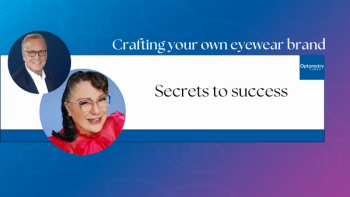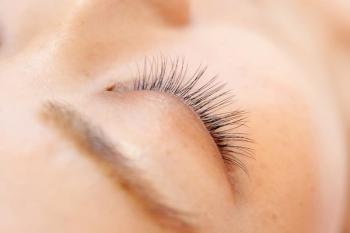
- January/February digital edition 2025
- Volume 17
- Issue 01
The dual advantage of a shorter lens replacement schedule
Both patient and provider benefit from reduced contact lens wear cycles.
As an eye care provider with a patient-first approach, I prefer shorter wear cycles for contact lenses, which may deliver improvements in comfort1 and overall patient compliance.2 What’s more, the residual business benefits of the resulting increased patient compliance and comfort3 correlate to better patient outcomes, satisfaction, and loyalty,4-6 and reduce the risk factors that may contribute to lens dropout.7 Though a shorter lens replacement schedule, such as for a daily disposable, has many advantages, some patients still require reusable lenses for various reasons. With increased innovations coming to market, new reusable lenses with shorter replacement intervals, such as a 1-week schedule, have the potential to satisfy the unmet needs of patients and providers alike.
With a wide range of contact lens replacement schedules and brands on the market, it’s imperative for patients to understand the key factors that impact their wearing experience and for providers to have patient lifestyle insights to help select the best lens and fit for each patient.
The beneficial impact of a regular lens replacement schedule on patient outcomes
The positive influence of a frequent lens replacement schedule for patients
Lasting comfort is still the No. 1 factor that drives which contact lens a doctor recommends and ultimately prescribes for a patient—comfort that lasts through the end of their patient's day, as well as throughout the entire replacement schedule.8 Research shows that 62% of contact lens wearers do not wear their lenses for longer periods due to some kind of discomfort—not because their day is over.8
Eye care professionals (ECPs) want patients to remove their lenses when they don’t need them, not because they can’t wear them anymore. Compliance is key to overall eye health. Nonadherence to contact lens replacement schedules makes patients more susceptible to bacterial and fungal infections and abrasions, which can lead to ocular damage. 9
In the lens prescribing process, one’s lens replacement schedule also plays a key role in comfort. According to research, frequent replacement of contact lenses prevents the buildup of deposits on the lens, offering a more comfortable experience.10 Patients with concerns about symptoms of dryness or allergies may also find daily disposable contact lenses are an option as they are designed to be worn for shorter periods.11
Due to these benefits, many ECPs prefer to fit patients with daily replacement lenses to ensure maximum comfort. Yet, dailies may not be suitable to a patient's lifestyle needs.
Exploring the relationship between improved patient and practice outcomes
By improving patient compliance and therefore comfort,3 ECPs can also improve patient outcomes and trust, increase patient satisfaction and loyalty,4-6 and reduce contact lens dropout.7
While compliance is important for a patient's contact lens comfort, it is also essential for practice success.12 One study found that patients who are not compliant with their lens replacement schedule are less likely to purchase an annual supply of contact lenses and have longer intervals between comprehensive eye examinations.5 Data shows that compliance is associated with greater patient satisfaction.4 The more satisfied a patient is with their outcome, the more trust they have in their health care provider.6 Meanwhile, trust has a strong, positive association with patient loyalty.6
Contact lens dropout can be a major problem for ECPs and their patients, with data showing the rate of contact lens–related dropouts at about 25% of wearers over a 2- to 3-year period.13 Other reports estimated the rate to be 12% to 27.4%.14 The primary reasons for dropout are understood to be discomfort and unsatisfactory vision.11 Research now shows an intimate link between comfort and vision.8 If a patient is not seeing well, they report that their lenses aren’t comfortable.8
Analyses indicate that if ECPs can reduce the dropout rate by just 3.5% annually from 2020 to 2040, they could potentially double the number of contact lens wearers in their practices Simple calculations show that if ECPs could reduce the dropout rate by as little as 3.5% yearly between 2020 and 2040, providers could double the number of contact lens wearers in their practices.15
When a daily disposable is not an option
While daily disposable lenses offer numerous benefits for patients, there remains a need for shorter replacement reusable lenses as daily disposable lenses may not be suitable for all patient needs or lifestyles.
Statistics show that while nearly 9 of 10 ECPs believe daily disposable SiHy lenses are better overall,16 more than half of new patients are still fit in reusable lenses17 with 8 of 10 selecting a reusable lens due to cost concerns.16 To help patients get closer to a daily disposable replacement lens, without the cost factor, eye care providers typically prescribe 2-week replacement lenses. However, research shows that 66% of 2-week wearers are noncompliant with the replacement schedule.2 Furthermore, nearly 3 of 4 surveyed US optometrists who fit contact lenses agreed that a 1-week replacement schedule would be more intuitive for their patients vs a 2-week contact lens replacement schedule.18
Cost concerns with daily disposable lenses and compliance challenges with 2-week replacement lenses have created a gap in the market for an affordable option with a simple replacement schedule, such as a 1-week replacement lens.
Through delivering comfort and compliance to a patient with a shorter contact lens replacement schedule, such as a 1-week lens, eye care practices can benefit from improved outcomes, and increased patient satisfaction and loyalty,4-6 and decreased factors that contribute to contact lens dropout.7 To better serve the modern patient's needs, the future of eye care must prioritize innovation in compliance, comfort, and affordability.As we look to the future of eye care, keeping innovation focused on compliance, comfort, and affordability will be key to better serving the modern patient’s needs.
References:
Van Der Worp E, Wolffsohn JS, Jones L. Dropping the dropout rate. Contact Lens Spectrum. 2020;35:36-40,42,43. https://clspectrum.com/issues/2020/may/dropping-the-dropout-rate/
Dumbleton K, Woods C, Jones L, Fonn D, Sarwer DB. Patient and practitioner compliance with silicone hydrogel and daily disposable lens replacement in the United States. EyeContact Lens. 2009;35(4):164-171. doi:10.1097/ICL.0b013e3181ac4a8d
Papas EB, Ciolino JB, Jacobs D; members of the TFOS International Workshop on Contact Lens Discomfort. The TFOS International Workshop on Contact Lens Discomfort: report of the management and therapy subcommittee. Invest Ophthalmol Vis Sci. 2013;54(11):TFOS183-203. doi:10.1167/iovs.13-13166
Dumbleton KA, Woods CA, Jones LW, Fonn D. The relationship between compliance with lens replacement and contact lens related problems in silicone hydrogel wearers. Cont Lens Anterior Eye. 2011;34(5): 216-222. doi:10.1016/j.clae.2011.03.001
Dumbleton K, Richter D, Bergenske P, Jones LW. Compliance with lens replacement and the interval between eye examinations. Optom Vis Sci. 2013;90(4):351-358. doi:10.1097/OPX.0b013e318288afcb
Liu S, Li G, Liu N, Hongwei W. The impact of patient satisfaction on patient loyalty with the mediating effect of patient trust. Inquiry. 2021;58:469580211007221. doi:10.1177/00469580211007221
Alcon data on file, 2021.
Alcon data on file, 2023.
Tips to avoid eye infections from contacts. Cleveland Clinic. December 2, 2024. Accessed December 20, 2024. https://health.clevelandclinic.org/avoid-eye-infection-from-contacts
Muhafiz E, Bayhan HA, Şahin S, Göçmen AY, Aslan Bayhan S, Gürdal C. Evaluation of the ocular surface in different contact lens replacement schedules. Cornea. 2019;38(5):587-594. doi:10.1097/ICO.0000000000001870
Davis E. The contact lens cheat sheet: multifocals, dailies, sclerals, and more. Eyes On Eyecare. August 11, 2023. Accessed December 20, 2024. https://eyesoneyecare.com/resources/contact-lens-cheat-sheet-multifocals-dailies-sclerals/
Rumpakis J, Brujic M. What contact lens dropout costs and how to prevent it. Contact Lens Spectrum. 2014;29:18,19,21-23,25.
https://www.clspectrum.com/issues/2014/september/what-contact-lens-dropout-costs-and-how-to-prevent-it/ Jones L, Efron N, Bandamwar K, et al. TFOS Lifestyle: impact of contact lenses on the ocular surface. Ocul Surf. 2023;29:175-219. doi:10.1016/j.jtos.2023.04.010
Pucker AD, Tichenor AA. A review of contact lens dropout. Clin Optom (Auckl). 2020;12:85-94. doi:10.2147/OPTO.S198637
Morgan P. What’s on my contact lens wish list. Contact Lens Spectrum. 2019;34:18-23. https://clspectrum.com/issues/2019/december/what8217s-on-my-contact-lens-wish-list/
Alcon data on file, 2022.
GfK $ shares used to approximate CLI sell in DD SiHy DD Non SiHy splits; Alcon data on file, 2022.
Based on a survey of 500 US optometrists who fit contact lenses; Alcon data on file, 2023.
Articles in this issue
9 months ago
Education should be current, relevant, useful10 months ago
Debunking myths about keratoconusNewsletter
Want more insights like this? Subscribe to Optometry Times and get clinical pearls and practice tips delivered straight to your inbox.

















































.png)


